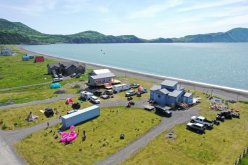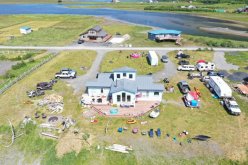Hello, as the topic states I have a small cabin on an island in Alaska and want to play with a small solar system. We have line power and I am in the works of getting an automatic generator installed to take care of the times high winds or something else takes out a pole/line for a few days. I have had a yeti 1250 for years now and have used it on and off when we have lost power. This project is purely for fun and I have no expectation of actually being able to run anything beyond stuff that I can plug into the yeti. Now I have quite a bit of solar gear already and more panels that I could likely use with the yeti, but that is what i am here asking you all for advice. Obviously here in Alaska we are not going to get alot of sun, and definitely more shaded days so the more panels I can potentially utilize without overloading the built in mppt controller the better.
I have:
2 150W HGST panels
-Open Circuit Voltage 22.7v
-Short Circuit Current 8.09a
-Optimum Operating Voltage 19.1v
-Optimum Operating Current 7.89a
9 100W Renogy panels
-Open Circuit Voltage 21.5v
-Short Circuit Current 6.4a
-Optimum Operating Voltage 17.1V
-Optimum Operating Current 6.1a
Yeti 1250 charging capability ( this was direct from GZ Support)
-Charging Port (input, 8mm) 16-48V, up to 10A (160W max)
-Power Pole Charging Port (input) 16-48V, up to 20A (320W max)
Total Max Input 320W
Now i have some y branch parallel connectors and in theory this is how I thought things could be connected, please forgive me if I seem to be missing some core solar knowledge with my understanding here.
The two 150 watt panels could be connected in series which would keep the amperage at 7.89 but bring the voltage to just under 40v. These two panels would be safe to connect to the 8mm input charging port since its under 10A and within the voltage range.
The 100 watt panels could be connected by 4 in a parallel connection which would bring the amperage to 24A and keep the voltage the same at 17V.
That is where i begin to get a bit confused on the limits...Can I actually only utilize 3 of the 100 watt renogy panels due to the 24A of 4 in parallel, or is the amperage irrelevant and I can actually hook up all 9 panels in parallel?
Thanks for any insight/advice you can provide!
I have photos of the panels and everything else if that is helpful..including a photo of my beach cabin for views.
I have:
2 150W HGST panels
-Open Circuit Voltage 22.7v
-Short Circuit Current 8.09a
-Optimum Operating Voltage 19.1v
-Optimum Operating Current 7.89a
9 100W Renogy panels
-Open Circuit Voltage 21.5v
-Short Circuit Current 6.4a
-Optimum Operating Voltage 17.1V
-Optimum Operating Current 6.1a
Yeti 1250 charging capability ( this was direct from GZ Support)
-Charging Port (input, 8mm) 16-48V, up to 10A (160W max)
-Power Pole Charging Port (input) 16-48V, up to 20A (320W max)
Total Max Input 320W
Now i have some y branch parallel connectors and in theory this is how I thought things could be connected, please forgive me if I seem to be missing some core solar knowledge with my understanding here.
The two 150 watt panels could be connected in series which would keep the amperage at 7.89 but bring the voltage to just under 40v. These two panels would be safe to connect to the 8mm input charging port since its under 10A and within the voltage range.
The 100 watt panels could be connected by 4 in a parallel connection which would bring the amperage to 24A and keep the voltage the same at 17V.
That is where i begin to get a bit confused on the limits...Can I actually only utilize 3 of the 100 watt renogy panels due to the 24A of 4 in parallel, or is the amperage irrelevant and I can actually hook up all 9 panels in parallel?
Thanks for any insight/advice you can provide!
I have photos of the panels and everything else if that is helpful..including a photo of my beach cabin for views.





